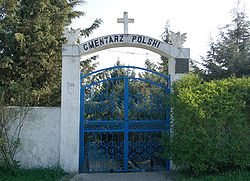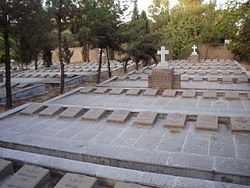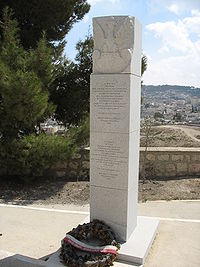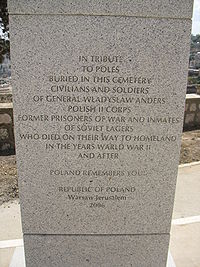
Anders Army
Encyclopedia

Polish Armed Forces in the East
Polish Armed Forces in the East refers to military units composed of Poles created in the Soviet Union at the time when the territory of Poland was occupied by both Nazi Germany and the Soviet Union in the Second World War....
in the period 1941-1942, in recognition of its commander Władysław Anders. The growing army, created in the USSR, provided the bulk of the units and troops of the Polish II Corps of the Polish Armed Forces in the West
Polish Armed Forces in the West
Polish Armed Forces in the West refers to the Polish military formations formed to fight alongside the Western Allies against Nazi Germany and its allies...
.
After the Soviet invasion of Poland
Soviet invasion of Poland (1939)
The 1939 Soviet invasion of Poland was a Soviet military operation that started without a formal declaration of war on 17 September 1939, during the early stages of World War II. Sixteen days after Nazi Germany invaded Poland from the west, the Soviet Union did so from the east...
in 1939 the Soviets effectively broke off diplomatic relations when they withdrew recognition of the Polish government at the start of the invasion. Up to 1.5 million Polish citizens, including over 200,000 Polish prisoners of war, were deported from Soviet-occupied Poland by the NKVD to the Gulags. Polish-Soviet diplomatic relations were re-established in 1941 after the German invasion of the Soviet Union
Operation Barbarossa
Operation Barbarossa was the code name for Germany's invasion of the Soviet Union during World War II that began on 22 June 1941. Over 4.5 million troops of the Axis powers invaded the USSR along a front., the largest invasion in the history of warfare...
forced Stalin to look for allies. Thus the military agreement from August 14 and subsequent Sikorski-Mayski Agreement
Sikorski-Mayski Agreement
The Sikorski–Mayski Agreement was a treaty between the Soviet Union and Poland signed in London on 30 July 1941. Its name was coined after the two most notable signatories: Polish Prime Minister Władysław Sikorski and Soviet Ambassador to the United Kingdom Ivan Mayski.- Details :After signing...
from August 17, 1941, resulted in Stalin agreeing to declare all previous pacts he had with Nazi Germany null and void, invalidate the September 1939 Soviet-German partition of Poland and release tens of thousands of Polish prisoners-of-war held in Soviet camps. Pursuant to an agreement between the Polish government-in-exile and Stalin, the Soviets granted "amnesty
Amnesty for Polish citizens in USSR
Amnesty for Polish citizens in USSR refers to an amnesty in USSR for those deprived of their freedom resulting in temporary stop of persecutions of Polish citizens under Soviet control....
" to many Polish citizens, from whom a military force was formed. Stalin also agreed that this military force would be subordinate to the Polish government-in-exile. A Polish Army on Soviet soil was born.
On August 4 the Polish military leader, General Władysław Sikorski, nominated General Władysław Anders, who had been just released from the Lubyanka
Lubyanka (KGB)
The Lubyanka is the popular name for the headquarters of the KGB and affiliated prison on Lubyanka Square in Moscow. It is a large building with a facade of yellow brick, designed by Alexander V...
prison in Moscow
Moscow
Moscow is the capital, the most populous city, and the most populous federal subject of Russia. The city is a major political, economic, cultural, scientific, religious, financial, educational, and transportation centre of Russia and the continent...
, as leader of the army. Meanwhile, another commander, General Michał Tokarzewski, had already began the task of forming the army in the Soviet town of Totskoye
Totskoye
Totskoye is a village in Orenburg Oblast, Russia. It is the administrative center of Totsky District. Population: 7,201 ....
on August 17. Anders issued his first orders and announced his appointment as commander on August 22.
The formation began to organize in the Buzuluk
Buzuluk
Buzuluk is a town in Orenburg Oblast, Russia, located on the Samara, Buzuluk, and Domashka Rivers northwest of Orenburg. Population: It was founded in 1736 as the fortress of Buzulukskaya on the Samara River near the mouth of the Buzuluk River along Russia's southern frontier. It was later moved...
area, and recruitment began in the NKVD
NKVD
The People's Commissariat for Internal Affairs was the public and secret police organization of the Soviet Union that directly executed the rule of power of the Soviets, including political repression, during the era of Joseph Stalin....
camps for Polish POWs. By the end of 1941 25,000 soldiers (including 1,000 officers) were recruited, forming three infantry
Infantry
Infantrymen are soldiers who are specifically trained for the role of fighting on foot to engage the enemy face to face and have historically borne the brunt of the casualties of combat in wars. As the oldest branch of combat arms, they are the backbone of armies...
divisions
Division (military)
A division is a large military unit or formation usually consisting of between 10,000 and 20,000 soldiers. In most armies, a division is composed of several regiments or brigades, and in turn several divisions typically make up a corps...
: 5th
5th Kresowa Infantry Division (Poland)
The Polish 5th Kresowa Infantry Division was an Polish Armed Forces in the West unit fighting during World War II in the Italian Front. It was formed in March 1943...
, 6th and 7th
Polish 7th Infantry Division
The 7th Infantry Division was the name of several units of the Polish Army.The original division was formed in 1918 and took part in shielding the Polish borders during the Polish-Ukrainian War. During the Polish-Bolshevik War it was commanded by Col. Szubert and reinforced to three brigades...
. Menachem Begin
Menachem Begin
' was a politician, founder of Likud and the sixth Prime Minister of the State of Israel. Before independence, he was the leader of the Zionist militant group Irgun, the Revisionist breakaway from the larger Jewish paramilitary organization Haganah. He proclaimed a revolt, on 1 February 1944,...
was among those who joined. In the spring of 1942 the organizing formation was moved to the area of Tashkent
Tashkent
Tashkent is the capital of Uzbekistan and of the Tashkent Province. The officially registered population of the city in 2008 was about 2.2 million. Unofficial sources estimate the actual population may be as much as 4.45 million.-Early Islamic History:...
, and the 8th
Polish 8th Infantry Division
The 8th Infantry Division was a tactical unit of the Polish Army. It was active in the Polish-Bolshevik War, as well as during the Invasion of Poland in 1939...
was also formed.

Katyn massacre
The Katyn massacre, also known as the Katyn Forest massacre , was a mass execution of Polish nationals carried out by the People's Commissariat for Internal Affairs , the Soviet secret police, in April and May 1940. The massacre was prompted by Lavrentiy Beria's proposal to execute all members of...
), the dispute with the Soviets over whether non-ethnic Poles and citizens of the Second Polish Republic
Second Polish Republic
The Second Polish Republic, Second Commonwealth of Poland or interwar Poland refers to Poland between the two world wars; a period in Polish history in which Poland was restored as an independent state. Officially known as the Republic of Poland or the Commonwealth of Poland , the Polish state was...
(Jews, Belarusians, Ukrainians) were eligible for recruitment, the Soviets assigning low priorities to the logistics
Logistics
Logistics is the management of the flow of goods between the point of origin and the point of destination in order to meet the requirements of customers or corporations. Logistics involves the integration of information, transportation, inventory, warehousing, material handling, and packaging, and...
of this project and their refusal to allow volunteers to leave USSR and join already existing and fighting Polish Armed Forces in the West
Polish Armed Forces in the West
Polish Armed Forces in the West refers to the Polish military formations formed to fight alongside the Western Allies against Nazi Germany and its allies...
. Another problem was that some administrators of Soviet labour camps and GULAG
Gulag
The Gulag was the government agency that administered the main Soviet forced labor camp systems. While the camps housed a wide range of convicts, from petty criminals to political prisoners, large numbers were convicted by simplified procedures, such as NKVD troikas and other instruments of...
officials were not too willing to release the Poles as they required the slave labour to meet their own production quota
Production quota
A production quota is a goal for the production of a good. It is typically set by a government or an organization, and can be applied to an individual worker, firm, industry or country. Quotas can be set high to encourage production, or can be used to limit production to control the supply of goods...
s.
On March 18, 1942, due to the Soviet authorities inability to provide adequate rations for the growing Polish Army, which was even then sharing its limited food with an also growing group of Polish civilians, Stalin agreed to evacuate part of the Polish formation as a military
Military
A military is an organization authorized by its greater society to use lethal force, usually including use of weapons, in defending its country by combating actual or perceived threats. The military may have additional functions of use to its greater society, such as advancing a political agenda e.g...
force to Iran after the Anglo-Soviet invasion of Iran
Anglo-Soviet invasion of Iran
The Anglo-Soviet invasion of Iran was the Allied invasion of the Imperial State of Iran during World War II, by British, Commonwealth, and Soviet armed forces. The invasion from August 25 to September 17, 1941, was codenamed Operation Countenance...
; and the unit was transferred across the Caspian Sea
Caspian Sea
The Caspian Sea is the largest enclosed body of water on Earth by area, variously classed as the world's largest lake or a full-fledged sea. The sea has a surface area of and a volume of...
to the port of Pahlavi (known today as Bandar-e Anzali
Bandar-e Anzali
Bandar-e Anzali , also Romanized as Bandar-e Pahlavī, Bandar Pahlavi, and Bandar Pahlevi, or simply as Pahlavī, Pahlevī, and Pehlevi; earlier, Enceli and Enzeli) is a city in and the capital of Bandar-e Anzali County, Gilan Province, Iran...
), Iran
Iran
Iran , officially the Islamic Republic of Iran , is a country in Southern and Western Asia. The name "Iran" has been in use natively since the Sassanian era and came into use internationally in 1935, before which the country was known to the Western world as Persia...
.

Under British command

Turkmenistan
Turkmenistan , formerly also known as Turkmenia is one of the Turkic states in Central Asia. Until 1991, it was a constituent republic of the Soviet Union, the Turkmen Soviet Socialist Republic . Turkmenistan is one of the six independent Turkic states...
(then part of the USSR) to the railhead in Mashhad
Mashhad
Mashhad , is the second largest city in Iran and one of the holiest cities in the Shia Muslim world. It is also the only major Iranian city with an Arabic name. It is located east of Tehran, at the center of the Razavi Khorasan Province close to the borders of Afghanistan and Turkmenistan. Its...
, Iran
Iran
Iran , officially the Islamic Republic of Iran , is a country in Southern and Western Asia. The name "Iran" has been in use natively since the Sassanian era and came into use internationally in 1935, before which the country was known to the Western world as Persia...
. As such, the unit passed from the Soviet control to that of the British government, and as the Polish Second Corps joined the Polish Armed Forces in the West
Polish Armed Forces in the West
Polish Armed Forces in the West refers to the Polish military formations formed to fight alongside the Western Allies against Nazi Germany and its allies...
. About 41 000 combatants and 74 000 civilians - Polish citizens - were able to leave the USSR with the Anders Army, joining the British High Command
Middle East Command
The Middle East Command was a British Army Command established prior to the Second World War in Egypt. Its primary role was to command British land forces and co-ordinate with the relevant naval and air commands to defend British interests in the Middle East and eastern Mediterranean region.The...
in the Middle East, traveling through Iran, Iraq
Iraq
Iraq ; officially the Republic of Iraq is a country in Western Asia spanning most of the northwestern end of the Zagros mountain range, the eastern part of the Syrian Desert and the northern part of the Arabian Desert....
and Palestine
Palestine
Palestine is a conventional name, among others, used to describe the geographic region between the Mediterranean Sea and the Jordan River, and various adjoining lands....
.
Palestine
When the Anders Army reached Palestine about 4,000 Jewish soldiers left the army. While some deserted, others, including Menachem Begin, obtained permission from Anders to depart their formations. Both groups joined the veteran settlements in the region. The mass departure of the Jewish soldiers was later called the "Anders AliyahAliyah
Aliyah is the immigration of Jews to the Land of Israel . It is a basic tenet of Zionist ideology. The opposite action, emigration from Israel, is referred to as yerida . The return to the Holy Land has been a Jewish aspiration since the Babylonian exile...
".

The Polish Jews in the Anders Army had additional goals besides fighting the Nazis. When the Anders Army left the Soviet Union on its journey towards the Middle East, families of the soldiers and groups of Jewish children, war orphans, joined the Jewish soldiers. After arriving in Tehran, Iran, the children were transferred into the hands of the emissaries who brought them to Palestine as the "Tehran Children".

Israel Defense Forces
The Israel Defense Forces , commonly known in Israel by the Hebrew acronym Tzahal , are the military forces of the State of Israel. They consist of the ground forces, air force and navy. It is the sole military wing of the Israeli security forces, and has no civilian jurisdiction within Israel...
. Many, including Menachem Begin, joined the Irgun
Irgun
The Irgun , or Irgun Zevai Leumi to give it its full title , was a Zionist paramilitary group that operated in Mandate Palestine between 1931 and 1948. It was an offshoot of the earlier and larger Jewish paramilitary organization haHaganah...
, a paramilitary organization that conducted terrorist activities in Palestine against Arabs and British rule.
In the year 2006 a memorial to the Anders Army was erected in the orthodox cemetery on Mount Zion
Mount Zion
Mount Zion is a place name for a site in Jerusalem, the location of which has shifted several times in history. According to the Hebrew Bible's Book of Samuel, it was the site of the Jebusite fortress called the "stronghold of Zion" that was conquered by King David, becoming his palace in the City...
in Jerusalem.
Notable veterans of the Anders Army
- Menachem BeginMenachem Begin' was a politician, founder of Likud and the sixth Prime Minister of the State of Israel. Before independence, he was the leader of the Zionist militant group Irgun, the Revisionist breakaway from the larger Jewish paramilitary organization Haganah. He proclaimed a revolt, on 1 February 1944,...
, the sixth prime minister (1977-1983) of Israel - Vincent Zhuk-HryshkevichVincent Zhuk-HryshkevichVincent Zhuk-Hryshkevich was a Belarusian politician and teacher.Vincent Zhuk-Hryshkevich studied at a Belarusian gymnasium in Budsław and then, after the gymnasium's closure, in the Belarusian Gymnasium of Vilnia from which he graduated in 1922....
, the future president of the Belarusian Democratic Republic in exile - Alexander NadsonAlexander NadsonFather Alexander Nadson is the Apostolic Visitor for Belarusian Greek-Catholic faithful abroad and a notable Belarusian émigré social and religious leader.Born Aliaksandar Bochka in the village Haradzieja near Niasvizh, he studied at the Niasvizh seminary...
, the future well-known Belarusian religious leader and Apostolic Visitor for Belarusian Greek-Catholic faithful abroad - Nikodem SulikNikodem SulikNikodem Sulik-Sarnowski, who used the noms de guerre "Jodko", "Jod", "Karol", and "Sarnowski" , was an officer of the Russian Imperial Army, and Generał brygady of the Polish Army.-Biography:...
- Alfons ManiuraAlfons ManiuraAlfons Maniura was a Polish soldier who fought in all three Silesian Uprisings...
- Leonid TeligaLeonid TeligaLeonid Teliga was a Polish sailor, writer, journalist, translator and the first Pole to single-handedly circumnavigate the globe on his yawl Opty.-Youth:...
- Stanislaw SzostakStanislaw SzostakStanislaw Szostak was a colonel of the Polish Armoured Corps.He was born in Berazino, today's Belarus, the son of Władysław and Maria Nieciejowska of Hrynica. He was injured in a car accident and died in 1961...

